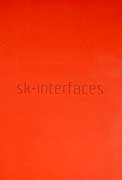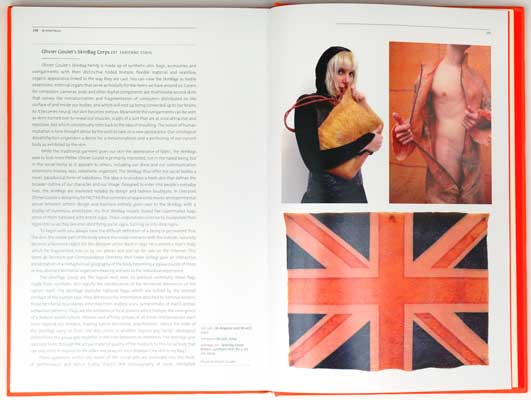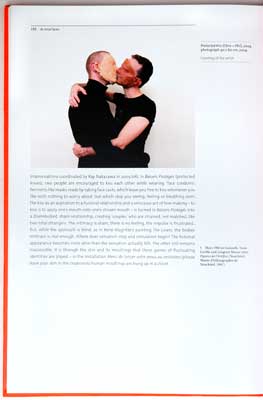


SkinBag Corps.ext
Fabienne Stahl
Olivier Goulet’s SkinBag family is made up of synthetic skin, bags, accessories and overgarments with their distinctive folded texture, flexible material, and seamless organic appearance linked to the way they are cast. You can view the SkinBags as bodily extensions, external organs which serve as holdalls for items we have around us. Covers for computers, cameras, pods and other digital components are multimedia second skins that convey the miniaturisation and fragmentation of computers distributed on the surface and inside of our bodies and which will end up being connected up to our brains. As it becomes neuronal, our skin becomes porous. Meanwhile the overgarments are seen as skins turned back over to reveal our muscles, scalps of a sort that are at once attractive and repulsive, but which conceptually refer back to the idea of moulting. The notion of human mutation is here brought about by the will to take on a new appearance. Our ontological dissatisfaction engenders a desire for a metamorphosis and a perfecting of our current body as exhibited by the skin.
While the traditional garment turns our skin appearance into fabric appearance, the SkinBags seek to look more lifelike. Olivier Goulet is primarily interested, not in the naked being, but in the social being as it appears to others, including our dress and our communicational extensions (money, keys, telephone, organiser…). The SkinBags thus offer our social bodies a novel, paradoxical form of nakedness. The idea is to produce a fresh skin that defines the broader outline of our character and our image. Designed to enter into people’s everyday lives, the SkinBags are marketed notably by design and fashion boutiques. In Liverpool, Olivier Goulet is designing for FACT his first commercial space extra muros, an experimental venue in between artistic design and business entirely given over to the SkinBag, with a display of numerous prototypes. Already his first SkinBag models looked like supermarket bags, some of them tattooed with brand logos. These corporations contrive to incorporate their logos into us as they become identifying, social signs, turning us into shop signs.
Always to begin with you have the difficult definition of a being in permanent flux. The skin, the visible part of the body where the inside interacts with the outside, naturally became an object of predilection for the designer artist. Already back in 1997, he scanned a man’s body which he fragmented into 10 cm2 pieces and put up for sale on the Internet. This "mail order territory sale" gave an interactive presentation of a metaphorical geography of the body becoming a jigsaw puzzle of more or less abstract territorial organisms bearing witness to the individual experience.
The SkinFlags (2003) are the logical next step. As political continuity, these flags in synthetic skin signify the obsolescence of the territorial dimension of the nation itself. The SkinFlags pastiche national flags that are sullied by the colonial conduct of the human race. They denounce the importance attached to national borders, those territorial boundaries inherited from endless wars, symptomatic of man’s archaic behaviour patterns. Flags are the emblems of local powers that hamper the emergence of a federative world culture. Interest and affinity groups of all kinds interpenetrate each other beyond our borders, making nation territories anachronistic. Hence the folds of the SkinFlags carry on from one skin colour to another; beyond any "racial", ideological distinctions, the group gels together in the links between its members. The SkinFlags give concrete form, through the actual material quality of the medium, to this social body that can only exist in relation to the other: "my skin is my flag".
These questions within the realm of the visual arts are extended into the fields of bodily expression of performance and dance (Cathy Sharp’s Skin choreography of 2006; Orbitallink improvisations coordinated by Ray Nakazawa in 2005/06). In Baisers Protégés (protected kisses), two people are encouraged to kiss each other while wearing "face condoms", masks hermetic like sheaths made by taking face casts, and which leave you free to kiss whomever you like with nothing to worry about, but which stop you seeing, feeling, or breathing even. The kiss as an aspiring to a fusional relationship and a sensuous act of love-making — to kiss is to apply one’s mouth onto one’s chosen mouth — is turned in Baisers Protégés into a disembodied, sham relationship, forming "couples" who are strained, not matched, like two total strangers. The intimacy is sham, there is no feeling, the impulse is frustrated… But, while the approach is blind, as in René Magritte’s painting The Lovers, the bodies’ embrace is real enough. Where does sensation stop and simulation begin? The fictional appearance becomes more alive than the sensation actually felt. The other still remains inaccessible.
It is through the skin and its moultings that these games of fluctuating identities is played — in the installation "please leave your skin in the cloakroom" human moultings are hung up in a closet.